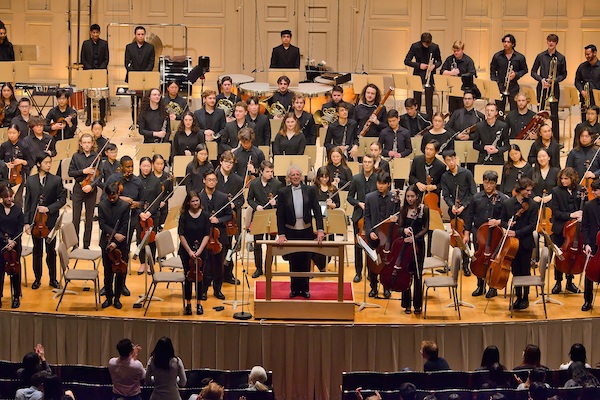Boston Philharmonic Orchestra & Boston Philharmonic Youth Orchestra in Concert

One of Cassadó’s former cello students is the conductor Benjamin Zander, who led his Boston Philharmonic (BPO) and Boston Philharmonic Youth Orchestras (BPYO) in concerts earlier this month at Symphony Hall. Both performances were available to stream via the orchestras’ website (which is how I heard them) and are well worth investigating when they migrate to the ensemble’s YouTube channel (or the conductor’s website).
This is a big year for Zander and the Philharmonic: the former celebrates his 85th birthday in March and the ensemble is currently in the middle of its 45th season. Yet the festivities have been tempered somewhat by the unexpected death in September of the maestro’s former wife, Rosamund Stone Zander. Despite their separation, the two remained close friends and Stone Zander was a guiding spiritual and philosophical light for both orchestras.
That fact was at the heart of the BPO’s concert taped last Friday, which paired dark-hued pieces by Benjamin Britten and Dmitri Shostakovich with Béla Bartók’s Piano Concerto No. 3.
Benjamin Hochman was the soloist in the last. Playing with a light touch and impressive textural clarity, he delivered a fresh, inviting performance that was highlighted by a rapturous account of the Concerto’s transcendent second movement.
Zander and the Philharmonic provided a warm, well-directed accompaniment, one that was often appealingly conversational and impressively balanced with the pianist. Afterwards, Hochman offered the “Sarabande” from Bach’s C-minor Partita as an introspective encore.
Those who’ve followed the BPO and BPYO long enough might recall a gripping, dancing performance of the Shostakovich Tenth Symphony Zander led with the Youth Orchestra in 2018. Friday’s account of the same work moved similarly (especially in the Allegretto), though this iteration came with a touch more melancholy than before.
To be sure, this was a reading that wrestled with suffering, hardship, and loss. But still it persevered, sometimes angrily and defiantly (like in the furious second movement), sometimes wistfully (as in the big first).
Ultimately, though, Zander’s Shostakovich was affirmative: the finale’s coda rang triumphantly in spite — or, perhaps, because — of all it took to arrive at that point. The process included some exquisite brass and woodwind contributions, not least of which were the solo turns from principal oboe Peggy Pearson and principal clarinet Rane Moore.
More terrific solos, these from principal violist Noriko Futagami, anchored the night’s performance of the Passacaglia from Britten’s opera Peter Grimes. Zander’s was a vigorous yet harrowing traversal of this mysterious score, whose repeating bass line emerged with implacable force.
Vigor and energy — though not the Passacaglia’s terrors — marked the BPYO’s concert from back on November 5. Their indestructibly Germanic program, which opened the group’s 12th season, featured music by Richard Wager, Paul Hindemith, and Johannes Brahms.
The ensemble’s Meistersinger Overture launched the event promisingly: plush, noble, beautifully blended. Zander lingered over some of the lyrical spots, but, given how well this orchestra plays, who could blame him? A couple of loose seams notwithstanding, this was some terrific Wagner, full of warmth and character, ending in a blaze of sonic light.

Benjamin Zander and the Boston Philharmonic Youth Orchestra. Photo: Hilary Scott
Those same aspects also marked the BPYO’s account of Hindemith’s Symphonic Metamorphosis on Themes by Carl Maria von Weber. The cumbersome title of this 1943 piece aside, this is as direct and wickedly personable a score as any in the canon. It’s clearly a Zander favorite — he last programmed the Metamorphosis with these forces in 2017 — and one can forgive its relatively quick reappearance on account of the orchestra’s swaggering, rhythmically crisp performance here.
The fast movements, highlighted by a bristling “Turandot, Scherzo” and propulsive closing “March,” were rightly exhilarating. Meanwhile, the Andantino functioned as a delicate, if slightly detached, respite.
Afterwards came the Brahms First Symphony in a reading that was full of color and direction, the reflective moments warm and well-blended, the fast ones snapping right along. Despite a few hiccups in the ensemble in the last two movements, the BPYO’s performance didn’t stint on might or character.
Indeed, Zander’s grasp of the music’s architecture ensured a purposeful flow. For icing (as it were), virtually all the Symphony’s solos — particularly those from concertmaster Darwin Chang and principal horn Graham Lovely — were dispatched with elegance and majesty.
Typically, if the Youth Orchestra gives an encore, it will be “Nimrod” from Elgar’s Enigma Variations. There was nothing to follow the Brahms on November 5, but Zander borrowed the piece from his young charges last weekend and played it as a post-Shostakovich memorial to his recently departed former wife.
As usual, he prefaced the reading by reminding the audience that this music, so often heard in a funereal context, isn’t actually about death: rather, it’s a testament to friendship and love. So it sounded here, tying together the night’s — and this bittersweet season’s — threads of loss, memory, and hope with poignancy, warmth, and not a drop of sentimental excess.
Click here to read the program.
 Jonathan Blumhofer - The Arts Fuse
Jonathan Blumhofer - The Arts Fuse